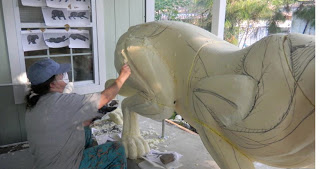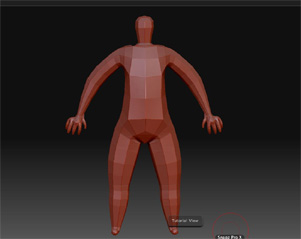Scanning
3DCAMP Houston Returns In 2012 With The Collaboration Of The University of Houston to Build STEAM
Press Release (Houston, TX—June 24, 2012) 3DCAMP Houston, a local organization supporting education in all things 3D, is proud to announce its return scheduled for Saturday, September 29. The University of Houston College of Natural Sciences and Mathematics and the School of Art will host 3DCAMP Houston 2012, featuring a number of expert speakers who will discuss 3D technologies and how they are impacting new and existing disciplines. This year the camp will also feature an art exhibition to showcase the impact of technology on art.
3D technology, once reserved for the likes of sophisticated science fiction films, has advanced to now include a myriad of artistic and scientific disciplines. This year’s camp will showcase these advancements with presentations exploring innovative technologies. From holographic paintings that tantalize the viewer to 3D printers that produce completely formed sculptures, there is something amazing for everyone to experience.
The goal of 3DCAMP Houston 2012 is to encourage and educate individuals about the use of 3D in various disciplines; therefore 3DCAMP 2012 is returning with STEAM, an educational initiative that supports 3DCAMP Houston educational goal of incorporating and encouraging the blending and education of Science, Technology, Engineering, Art and Math (STEAM).
“The College of Natural Sciences and Mathematics at the University of Houston is pleased to help further the community’s appreciation and knowledge of the many aspects of 3D applications in our modern world. The rapid evolution in visualization technology is playing a critical role in advancing many important areas, from medical and surgical techniques to new methods of energy realization and information transmission,” said Mark A. Smith, dean of the college. “With the university playing a critical role nationwide in these developments, it is satisfying as well as natural to help bring this understanding to our community through 3DCAMP 2012.”
Rex Koontz, director of the university’s School of Art added, “Technology, art and design are converging into a significant force on our cultural and economic landscape. The School of Art welcomes the opportunity to work with the cast of 3DCAMP to further the goal of creating synergies between art and technology.”
3DCAMP Houston is an all-day event and is open to the public. It features lectures and presentations from professionals in the arts, architecture, engineering, science and much more. Online registration will open in July at www.3dcamphouston.com
Vendors will be on hand to demonstrate the possibilities and uses of some of the most interesting and mind-blowing 3D technology. “The Third Dimension,” an art exhibition comprised of 3D art, will be open to the public on Friday, September 28.
For more information concerning 3DCAMP Houston 2012, the art exhibition, and volunteer opportunities please visit www.3dcamphouston.com.
Media Contact:
Bridgette Mongeon
Please feel free to repost this press release, with photo credits.
UPDATE- COUNTDOWN BEGINS!
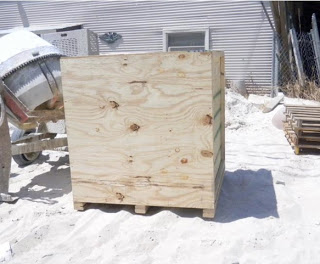
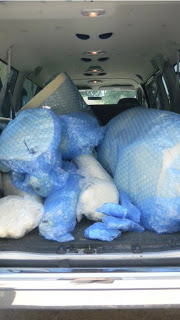
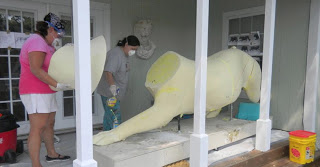
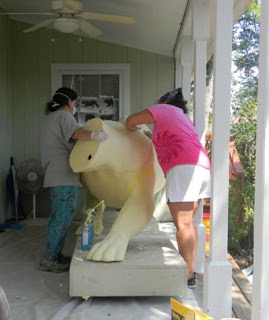
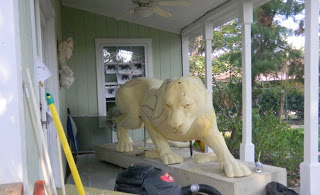
* The Sculpting process begins. The foam is soft and allows me to carve into it before we add the clay. The foam piece becomes the armature that the clay will be added to. Muscles are sketched in and now I begin the process of roughing in the body. Friday 3 people are schedule to put the two layers on the foam. one is wax to seal the foam the other is clay. I hope I can be ready. These are long gritty days. I could use some Prairie View A & M cheers here. Just 16 days before I am hoping to get approval.
This is a sculpture for Prairie View A & M University in Prairie View, Texas of their mascot the Prairie View Panther. The entire process is being recorded on a special blog designate for this project and can be found at http://www.prairieviewpanther.blogspot.com/
A New Book Proposal
I just sent a new book proposal to the publisher. Art and Technology- Exploration of resources and advancements in digital sculpting, printing, milling and scanning. I know, I am just able to breath after fishing Digital Sculpting with Mudbox Essential Tools and Techniques for Artists.
I’m also knee deep in the Art and Technology podcast and the new website at http://www.digitalsculpting.net
The new book project is terribly exciting. It will feature a great deal of the research I am doing on this subject for my graduate studies. As I stated in the book proposal.
Art and Technology- Exploration of resources and advancements in digital sculpting, printing, milling and scanning. Finally, a resource guide for understanding and accessing tools in digital printing, milling and scanning. This technology is not just for manufacturing or engineering but can be embraced by designers, traditional and graphic artists who want to utilize these technologies in their creativity and in their workflow. This resource breaks down the process and possibilities for artists.
This book helps to inspire, as artists can see what others have created and push their imagination utilizing new technology. The technology can help save artists time and help artists create in ways that have never been conceivable until this time. Inspiration- strengthens your creativity and enlarges your artistic tool set.
I should know something in two – three weeks.
A Comparison Between Traditional And Digital Armatures— or Banging ZSpheres Into Submission
by Bridgette Mongeon ( this is a free article. You may copy it for your website. Follow information below.)
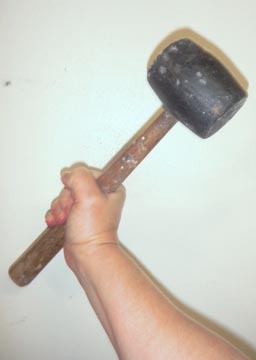
armatures into submission. Not so
with digital. HOLD ME BACK!
As a traditional sculptor who has spent 30 years of creating physical objects I am moving into digital technology and instead of just creating in my dusty studio, I am also creating within the box, the computer, that is on my desk, in my office. Presently I am working on the mesh or ZSpheres of a model in Pixologic’s ZBrush. I’m moving on to the 6th revision of this model. It is as tedious, if not more so, as the creating of a traditional life-size or monumental armature, but it is also just as necessary.
Picture this; you are in the throws of creating traditionally. The art is materializing before your eyes and you have all of the excitement that goes along with it, but without a proper armature for you clay to sit on; the traditional sculptor knows that you can walk into your studio one morning and find that your masterpiece has crumbled to the ground, sagged or broken into pieces.
Here I sit. My tools are different. It is not a welding rod, spray foam, chicken wire and mallet. It is a Cintiq tablet and a stylus pen. I have pushed and pulled ZSpheres and struggled with the ZSphere model for a week. (Pixologic tutorials state that creating this digital armature would be much easier if I had ZBrush 3.5. Zbrush 3.5 is only offered to those working on the PC and not available to Mac users at this time. ) If I had it, then I would have access to ZSketch, a tool that the Pixologic web site states is, “A new technology based on the ZSphere which will let you freely create your models without restrictions.” This is supposed to be much more intuitive and more like traditional sculpting. It is supposed to make creating the digital armature model, or mesh easier. I would even resort to moving to a PC to create in the ZSketch if I had a copy of ZBrush 3.5 for the PC, and it was true about the miraculous ability of this ZSketch. Then I could bring the sculpture back into my Mac using ZBrush for sculpting.
The process of “easily” creating a model to sculpt on, from scratch, in either Pixologics ZBrush or Autodesk’s Mudbox, in this sculptor’s opinion, is the missing link in these “intuitive” sculpting programs. This is a huge hindrance for those traditional sculptors who might like to utilize these tools in their own workflow. Without an easy way of digital modeling your armature through pushing and pulling on the screen, it is necessary to incorporate other means of 3D modeling. That would mean learning a modeling program, such as 3D’s max, Maya, Cinema 4D, Lightwave, Carrara or blender. For me, these programs feel even less intuitive to the traditional sculpting process. Modeling in a software program does not compare to the traditional process of sculpting. Hiring someone to create a digital model for my artwork feels similar to the process of hiring someone to create a traditional armature and roughing in the design. To me, hiring someone makes the process feel less organic; I feel divorced from an integral part of the creative process.
Here I sit. My tools are different. It is not a welding rod, spray foam, chicken wire and mallet. It is a Cintiq tablet and a stylus pen. I have pushed and pulled ZSpheres and struggled with the ZSphere model for a week. (Pixologic tutorials state that creating this digital armature would be much easier if I had ZBrush 3.5. Zbrush 3.5 is only offered to those working on the PC and not available to Mac users at this time. If I had it, then I would have access to ZSketch, a tool that the Pixologic web site states is, “A new technology based on the ZSphere which will let you freely create your models without restrictions.” This is supposed to be much more intuitive and more like traditional sculpting. It is supposed to make creating the digital armature model, or mesh easier. I would even resort to moving to a PC to create in the ZSketch if I had a copy of ZBrush 3.5 for the PC, and it was true about the miraculous ability of this ZSketch. Then I could bring the sculpture back into my Mac using ZBrush for sculpting.
Though creating armatures both traditionally and digitally is tedious work, it is this primal time of the creation that the “feel” of a sculpture presents itself and entices the artist to the creative dance. Another option to modeling is to rough in a small sketch, in traditional clay. A simple roughed in clay that shows form and gesture. Then, scan this sculpture with a 3Dscanner. We are using the Next Engine Scanner in the process. This process is what I call tra-digi art. I discuss it process in the New Mudbox book “Digital Sculpting with Mudbox: Essential Tools and Techniques for Artists” By Bridgette Mongeon and Michael de la Flor. It is necessary to note that scanning is still not a smooth transition. It will be necessary to retopologize this scan to be able to work on it in either ZBrush or Mudbox. The reason is that scanned models are in triangles, and it is necessary to have a model made with quads, or you will, once again, have artifacts and problems down the road. For a better description of why this is important check out this wonderful video on Subdivision Topology: Artifacts at Guerilla CG.
Learning how to retopologize is not as difficult as learning modeling in another program, but it is still work, and not as “true to the process of traditional sculpting.”
So, back to ZSpheres. The frustration of working with ZSpheres without ZSketch can be compared to the experiences I have downstairs in the traditional studio space. The only difference is when a traditional sculpture will not bow to my will; I will take a hammer from my closet of tools and bang the armature into submission. This technique is also an excellent relief of some of my own creative frustration. Working in ZBrush with ZSpheres allows me to push and pull without the physical effort or the clay under my nails. But my digital armature is far from being complete or correct and I am beginning to feel the need for a hammer.
With 30 years of experience in a traditional studio, I intuitively know what will or will not work in armature building. In the traditional studio, the type of armature I make and the type of clay used will depend on what final results I am after. Is this wet clay or is it wax-based clay? Will I be cutting this sculpture off the armature and then hollowing it out for firing or will I be sawing the armature apart with a reciprocating saw, dividing it up into many pieces to go to a foundry for mold making and bonze casting? These are questions I ask myself before beginning a traditional armature. The answers give me direction to create the appropriate support.
I do not have this same experience or intuition of digital armature building. I have no doubt that in the very near future, I will be working along on my digital creation, long after the building of the model or mesh and then I will find I cannot get the tool to work properly. An artifact or a bump in the sculpture’s topology—the underlying armature, will most likely be the cause. I will not be able to smooth and I will not be able to sculpt. I will wish I spent more time on creating a proper ZSphere model.
As with traditional sculpture, I must know what my final output will be. If this sculpture creation, that sits within the computer, is to be used in animation, then this armature or model needs to be created in such a way that the final piece can be animated. Bad topology or a bad mesh can cause problems in texturing and even the final rendering. In other words, I will not be able to generate an image of my creation.
My plans are to continue on with this digital model and invite a seasoned pro to my office to look at my digital armature, and perhaps give me some solutions and tricks in working with ZSpheres. Meanwhile, I check with the Pixologic website daily, to see if they are announcing the Mac version of ZSketch, so that I may prove for myself that it certainly does work more like traditional sculpting. And oh yes, I’ll keep the hammer downstairs in the traditional studio, just incase I get the urge to bang my mesh into submission and in doing so destroy my very costly equipment.
*
Bridgette Mongeon is a sculptor and writer and co-author of the new book
“Digital Sculpting with Mudbox: Essential Tools and Techniques for Artists”
She is also the host of a new podcast called Art and Technology
“A fire side chat where innovation, creativity, technology and science meet. ” For more information visit the artists blog
*
This is a free article you are welcome to use it on your website or blog. It must incorporate the writer/artist credit above.
Please also download all of the photographs to your own server.
3D Camp Houston Was A Success. Next Year Bigger And Better.
It was last Wednesday that my husband invited me to the 3D modelers and animators meetup. I was interested in the presentation on Zbrush by Johannes Huber. It was there that I met David Morris. David told me about a project he had been working on for just 8 weeks. It was a 3D camp, planned for this past weekend. He envisioned a place where people could get together and talk about 3D. My husband Mike delaflor and I jumped on board.

David was doing exactly what I wanted to do. I had actually been thinking about this for a year. I was going to do it this fall, but instead decided to perhaps make it a part of my graduate practicum. I had already talked to Next Engine, who have some wonderful affordable desk top scanners. Ex One who you have seen in previous posts. I have been contacting them about their direct metal printing and last month I went to see there printing sandcasting Molds. Ex One said when I was ready to get this going they would try to get Shapeways on board. For those of you who don’t know about Shapeways they are affordable service bureau for 3d digital printing, and they too are now offering digital printing in metal!
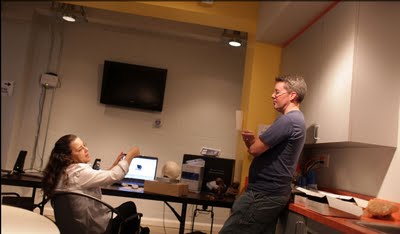
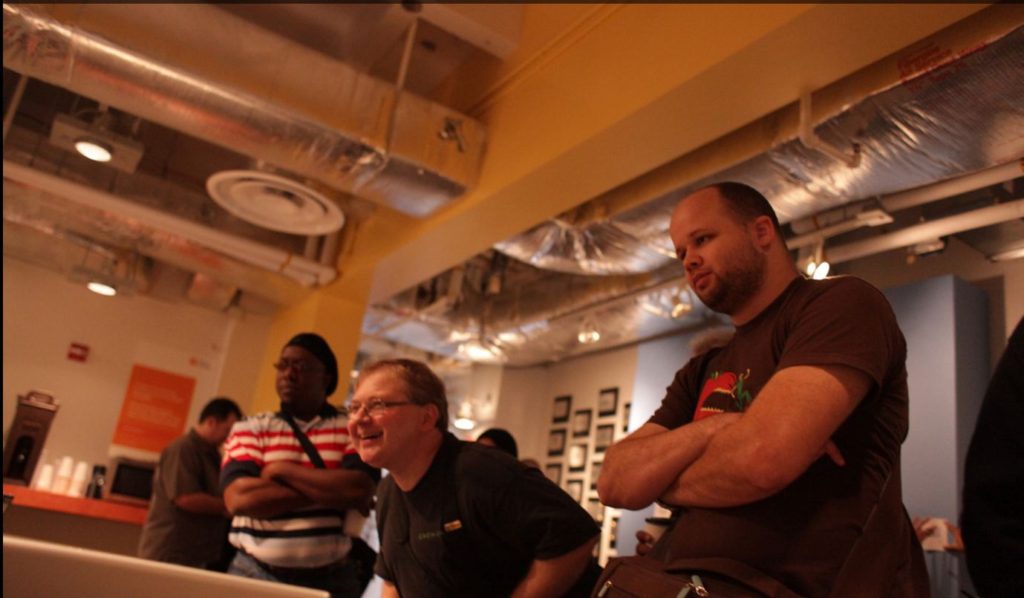
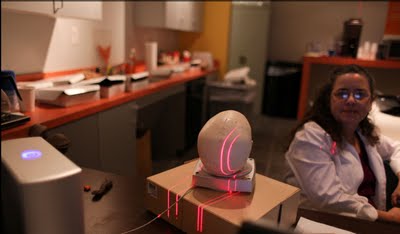
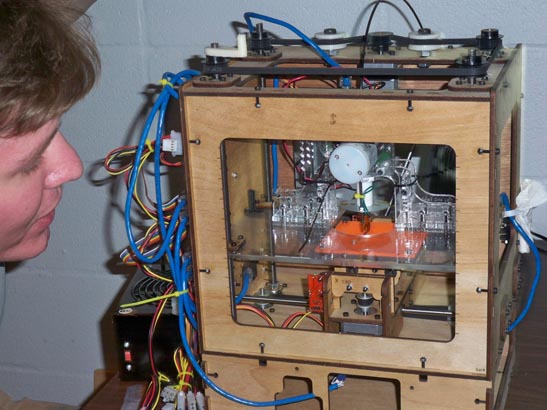
My goal was to get some vendors there and also offer some informative lectures on different processes of 3D. Well David did just that with 3D camp. I’m so excited and totally impressed with this young man. I think you will see this 3D camp grow in the up and coming years. I’m looking forward to presenting next year, and hopefully get the above vendors to demonstrate.
This year I demonstrated the 3D scanner, though I must say it was a crowded area and hard to get a good scan with so many people bumping the table. Still I get was able to sing the praises of this scanner that we are reviewing and using in our up and coming book, Digital Sculpting with Mudbox: Essential Tools and Techniques For Artists.
I also had this video playing and my article that I wrote for Sculpture Review on digital printing and milling where I talked about the incredible advances of Synappsys digital printing and their Data Direct to Mold process that is being used on The American.
My vantage point of 3D is coming from a traditional studio and using it to create traditional art. I suppose my focus then is a bit different than the traditional 3D artist. My graduate studies at Goddard- A Master of Fine Arts In Interdisciplinary Arts is based upon bridging the gap between the traditional and the digital studio. That is my interest. Though I have to admit, programs like Mudbox and Z brush are very intriguing and I expect I will be using them much more in the future. Oh no am I converting? Still I like the clay under my nails and my heart longs for dirty hands.
I encourage others to get involved with 3D camp next year, and plan on attending. I’m expecting it will double if not triple in size with a year of planning, some more backers, and some good promotion. If you would like to be a sponsore, If you are interested in presenting or are a vendor that would like to show at 3D camp next year please feel free to contact me or David.
Great job David!
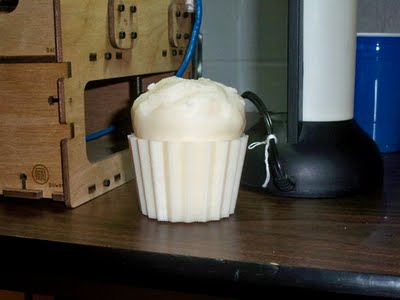
Some of my favorite things there revolve around output. This is a home made cnc router machine. To check it out further go to http://buildyourcnc.com/default.aspx
Many seemed to be interested in what a fine artist had to say in a 3D camp.
Another of my favorite had to again deal with output. It is the homemade 3D printer. This one is called the cupcake, and I must show that it can print a cupcake. I believe the cupcake costs about 700. to put together. There is another homemade one that I want to investigate but it costs approximately 3,000. Kind of steep to do for a hobby or to check out, but this other can print ceramic and chocolate, something worth investigating. I plan on reviewing all of these home made machines in an upcoming article.




